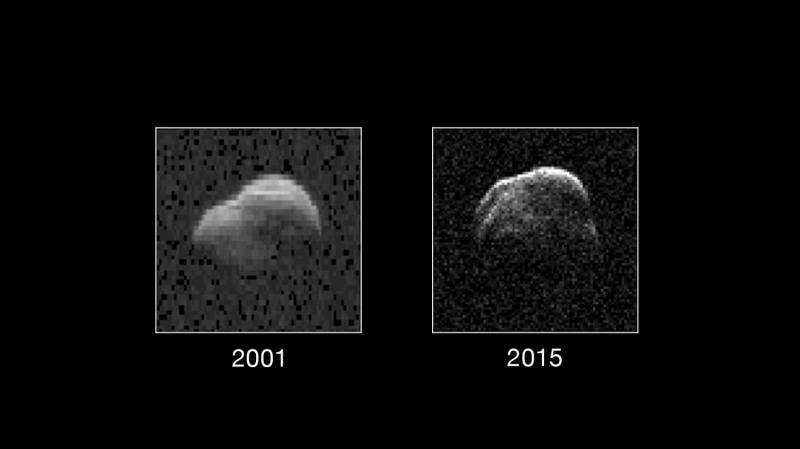Asteroid looks even better second time around

Asteroid 1998 WT24 safely flew past Earth on Dec. 11 at a distance of about 2.6 million miles (4.2 million kilometers, 11 lunar distances). During its flyby, NASA scientists used the 230-foot (70-meter) DSS-14 antenna at Goldstone, California, to probe it with microwave transmissions. Using this technique, they created the highest-resolution radar images of the asteroid.
This is the second time asteroid 1998 WT24 has been in the sights of NASA's solar system radar. In December of 2001, Goldstone obtained the first radar images of 1998 WT24 (nasa.gov/images/1998wt24.html" target="_blank">neo.jpl.nasa.gov/images/1998wt24.html), which revealed that the asteroid was about 1,300 feet (400 meters) in diameter and shaped like a Russet potato. The radar images from 2001 had a resolution of about 60 feet (19 meters) per pixel.
The new radar images achieve a spatial resolution as fine as 25 feet (7.5 meters) per pixel. They were obtained using the same DSS-14 antenna at Goldstone to transmit high-power microwaves toward the asteroid. However, this time, the radar echoes bounced off the asteroid were received by the National Radio Astronomy Observatory's 100-meter (330-foot) Green Bank Telescope in West Virginia.
"With this upgraded resolution we can see the asteroid's ridges and concavities in much greater detail," said Shantanu Naidu, a postdoctoral researcher at NASA's Jet Propulsion Laboratory in Pasadena, California, who works with the radar team and set up the observing plan for the asteroid's flyby. "One or two other radar bright features that could be outcrops on the surface are also visible."
The next visit of asteroid 1998 WT24 to Earth's neighborhood will be on Nov. 11, 2018, when it will make a distant pass at about 12.5-million miles (52 lunar distances).
Naidu noted JPL's asteroid radar team is also preparing to observe asteroid 2003 SD220, which will make its closest approach on Dec. 24 at about 28 lunar distances.
"From optical observations, we know it could be anything between a few hundred meters and a few kilometers wide and that it is on NASA's list as a potential human-accessible target, said Naidu. "But that is about it. Using radar, we should be able to see the shape of the object. For me, that is what makes this job so exciting. Every time we observe something, we are seeing something nobody has ever seen. We are making an unknown known, and as a scientist what can be better than that?"
Radar is a powerful technique for studying an asteroid's size, shape, rotation, surface features and surface roughness, and for improving the calculation of asteroid orbits. Radar measurements of asteroid distances and velocities often enable computation of asteroid orbits much further into the future than would be possible otherwise.
NASA places a high priority on tracking asteroids and protecting our home planet from them. In fact, the U.S. has the most robust and productive survey and detection program for discovering near-Earth objects (NEOs). To date, U.S. assets have discovered about 98 percent of known NEOs.
In addition to the resources NASA puts into understanding asteroids, it also partners with other U.S. government agencies, university-based astronomers, and space science institutes across the country, often with grants, interagency transfers and other contracts from NASA, and also with international space agencies and institutions that are working to track and better understand these objects. In addition, NASA values the work of numerous highly skilled amateur astronomers, whose accurate observational data helps improve asteroid orbits after they are found.
JPL hosts the Center for Near-Earth Object Studies for NASA's Near-Earth Object Observations Program within the agency's Science Mission Directorate.
Provided by NASA





















